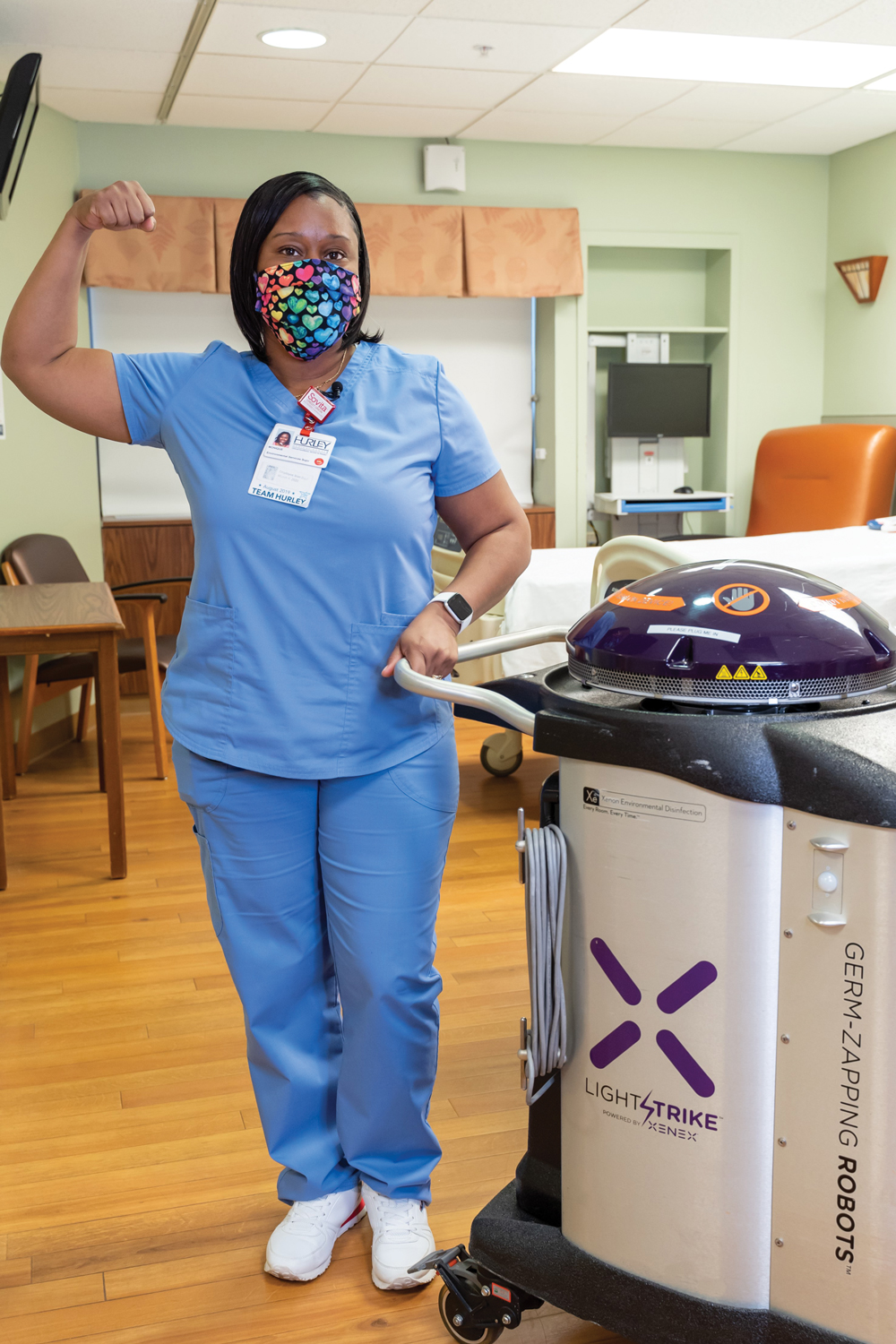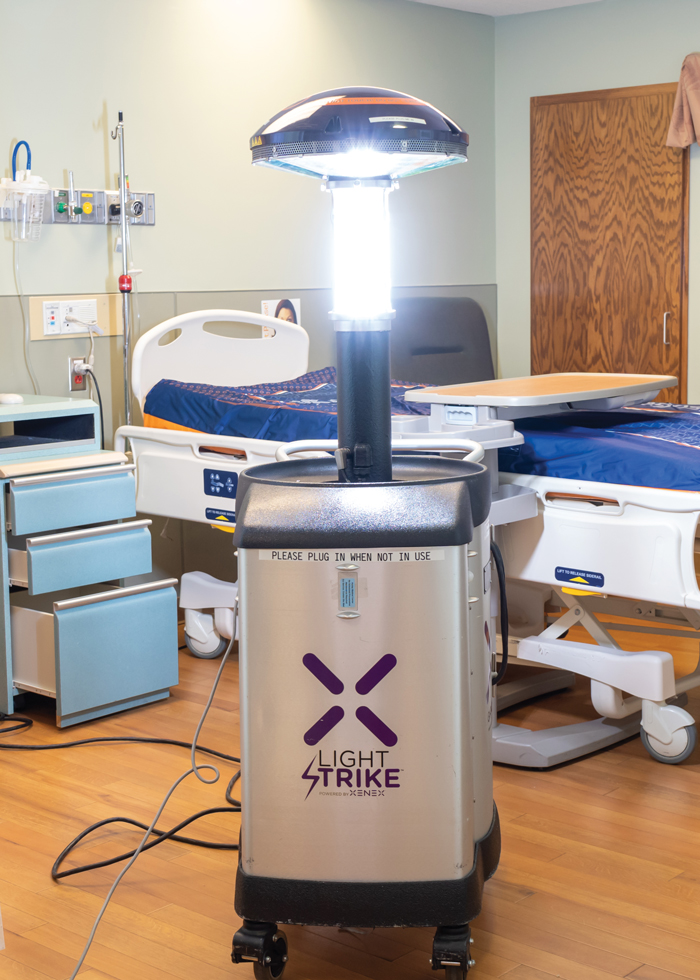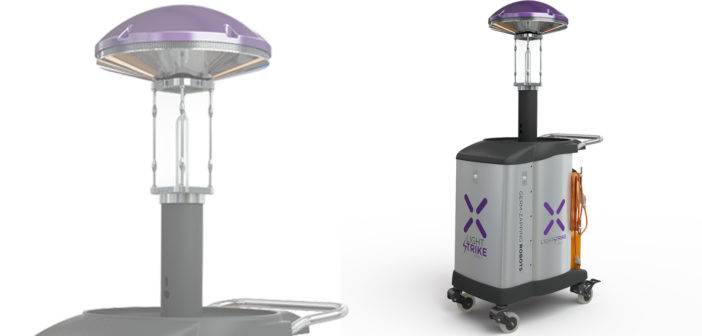 In the battle against COVID-19, disinfection of common contact areas is paramount. When it comes to decreasing hospital-acquired infections, Hurley Medical Center has recently “upped their game” through the use of three new Xenex LightStrike™ Germ-Zapping™ Robots. The futuristic machine is leading the way in medical technology. So, what is LightStrike? How does it work? And, what does it mean for Hurley patients? My City Magazine recently spoke with Ann Newell, Infection Control Director for Hurley Medical Center, about their new germ-zapping bots.
In the battle against COVID-19, disinfection of common contact areas is paramount. When it comes to decreasing hospital-acquired infections, Hurley Medical Center has recently “upped their game” through the use of three new Xenex LightStrike™ Germ-Zapping™ Robots. The futuristic machine is leading the way in medical technology. So, what is LightStrike? How does it work? And, what does it mean for Hurley patients? My City Magazine recently spoke with Ann Newell, Infection Control Director for Hurley Medical Center, about their new germ-zapping bots.
MCM: What is the LightStrike Robot?
AN: This technology uses intense ultraviolet (UV) light to disinfect rooms and equipment at healthcare facilities. It was created by a team of infectious disease epidemiologists to reduce hospital-acquired infections by “zapping” and killing germs. To combat dangerous microorganisms and help facilities achieve reductions in infections, Hurley has bundled the LightStrike robots with infection prevention expertise, customized disinfection protocols and trained the Environmental Service staff to follow a comprehensive infection prevention program. After a patient with COVID-19 left a room, we disinfected that room using LightStrike. We also use it in operating rooms and every intensive care patient room.
MCM: How does it work?
AN: The sun emits UVA, UVB and UVC radiation, but UVC never gets to earth because it’s blocked by the ozone layer. LightStrike uses UVC, which is effective at deactivating the RNA and DNA of bacteria and viruses because they have never been exposed to it and have no defense. To create the intense UVC light needed to destroy bacteria, viruses, mold, fungus and spores on hospital surfaces, LightStrike uses pulsed xenon, an environmentally-friendly inert gas. The robot works quickly and does not require warm-up or cool-down time, so facilities are able to disinfect dozens of rooms per robot per day. Hurley has integrated the Xenex infection prevention programs, including LightStrike robots, to supplement our own environmental disinfection efforts. This technology is safe for patients and staff and won’t damage our equipment.
MCM: What major viruses and bacteria does it clean or “deactivate”?
AN: In a five-minute disinfection cycle, LightStrike robots are able to deactivate viruses, bacteria and spores on surfaces. Surface decontamination technologies that utilize pulsed xenon UV are effective at reducing microbial burden when used with manual cleaning. The contamination of surfaces by SARS-CoV-2 poses a grave threat to the safety of healthcare workers, patients, frontline responders, military service members and global citizens.
MCM: What does this mean for Hurley and its patients?
AN: Hurley is setting a higher standard in environmental disinfection – we believe that even one healthcare-associated infection is too many. We are committed to saving lives and reducing suffering by destroying deadly microorganisms that cause infections. Patients can know they have a clean, disinfected environment at Hurley. Patient safety is more than words, it is our commitment.

MCM: How has LightStrike affected the statistics and rate of hospital-acquired infections?
AN: Hurley has seen a decrease in C. diff infections and surgical site infections. Xenex has multiple peer-reviewed healthcare-associated infection outcome studies that have validated a reduction in infections. Hurley chose the LightStrike robot based upon review of these studies that show positive results.
MCM: How has it helped Hurley during COVID-19?
AN: When patients are admitted with violent respiratory symptoms, they project small water droplets into the nearby environment. Those contaminated droplets infect the surface area of nearly everything in the room. Environmental Service workers are trained to perform an intense cleaning/disinfection
process to manually remove microorganisms in the hospital. LightStrike offers an additional layer of protection and has been proven to disinfect COVID-19.
MCM: What is the next step for Hurley?
AN: Prior to COVID-19, Hurley was using two LightStrike robots. During the health crisis, Hurley saw the need to ensure our patients and healthcare workers had the highest level of safety against COVID-19 and purchased a third robot. Hurley is exploring the opportunity to purchase a fourth machine to ensure all areas of the hospital have the added layer of protection. We are excited to start expanding the use of LightStrike.














